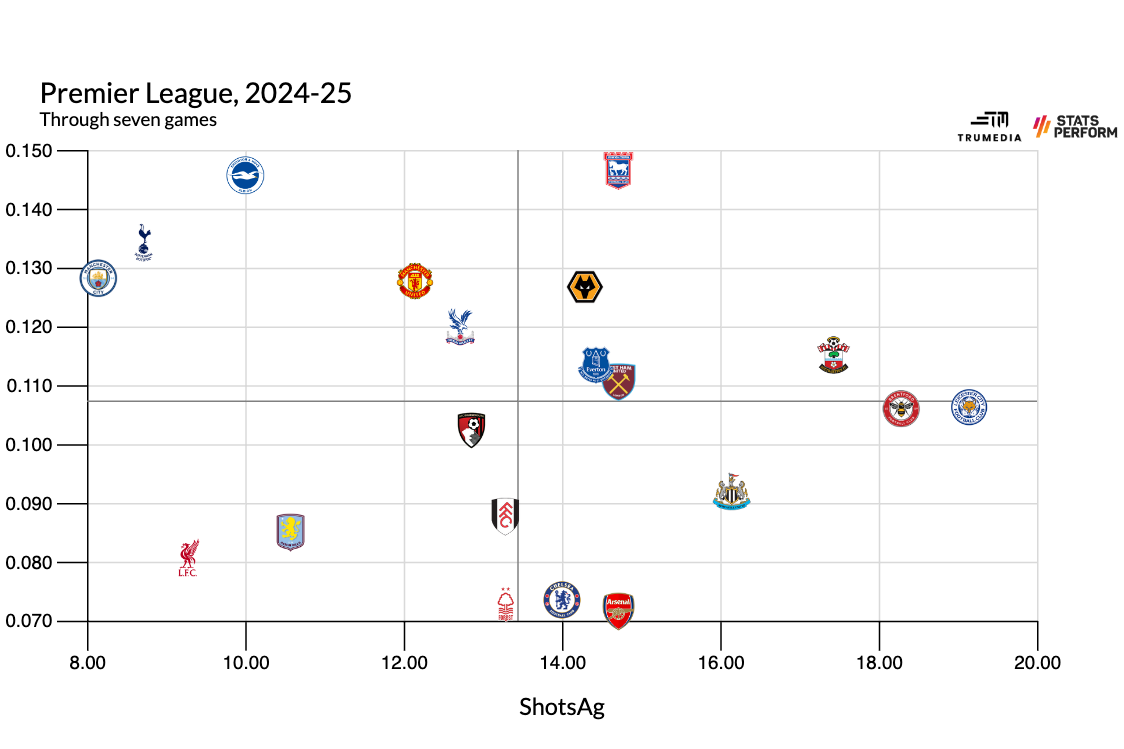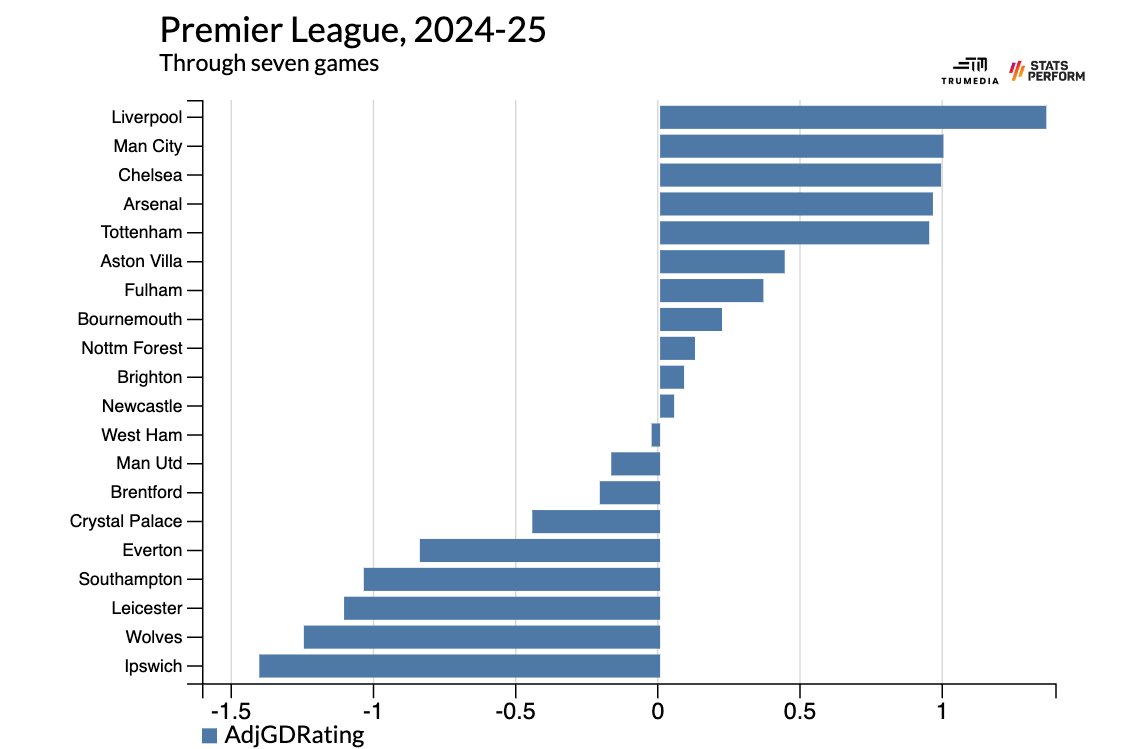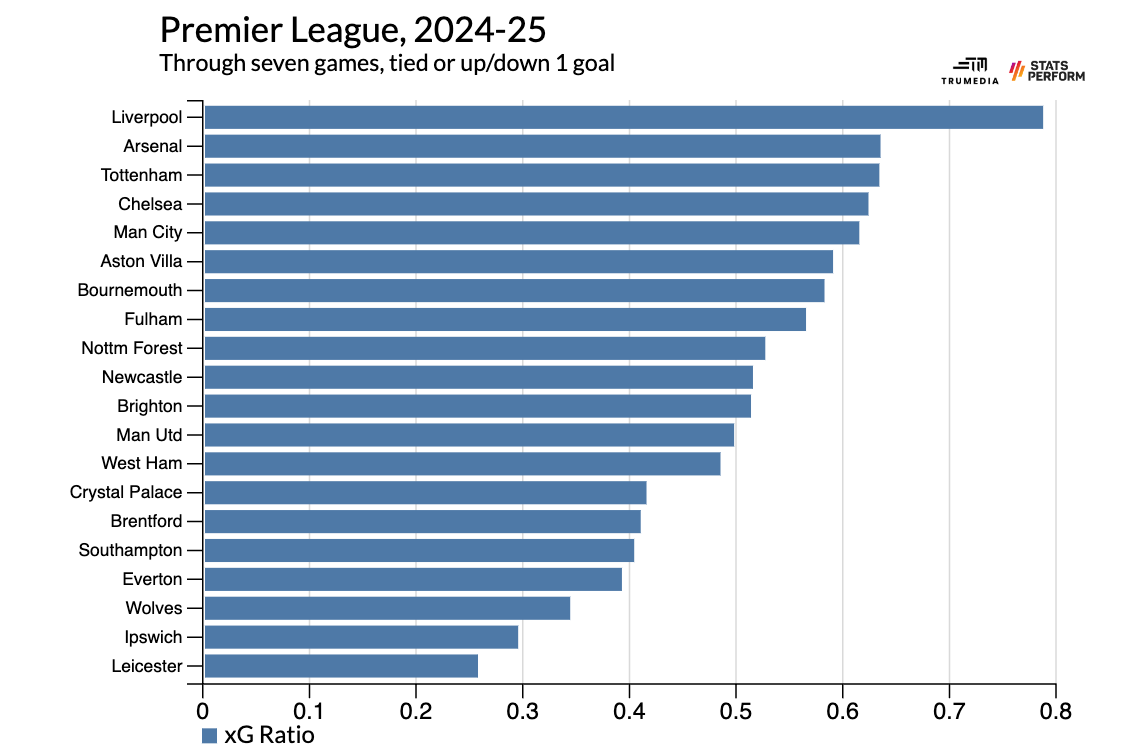It couldn't be going much better for Arne Slot right now. In fact, it has never gone better for any Liverpool manager. His side has won nine of its first 10 matches in all competitions -- the best 10-game start for any boss in the club's history.
That might even be underselling how well things have gone. In the history of the Premier League, no other manager hired in the offseason has won more points (18) or produced a better goal differential (plus-11) than Slot through his first seven matches in the league. Only one has matched both marks, and another equaled the points total but landed one back on goal difference. The latter is Carlo Ancelotti, the former is Pep Guardiola.
So, the past two managers to win the Champions League ... and Slot. Not bad company, huh?
Over the summer, Liverpool lost one of the greatest managers in the history of the sport in Jurgen Klopp and barely added any personnel to the squad. New goalkeeper signee Giorgi Mamardashvili is staying with Valencia on loan for another season, while the only first-team addition, Federico Chiesa, has played just 19 garbage-time minutes in the league.
Despite all that, Liverpool haven't missed a beat. In fact, they might be even better than they were last season. How are they doing it? Let us rank the reasons.
1. The foundation was already in place
Let's start with the obvious: it's not like Slot was taking over some teardown job. While the pursuit of defensive midfielder Martin Zubimendi over the summer -- and Moisés Caicedo the summer before that, and Aurelien Tchouameni the summer before that -- suggests the club feel like they can improve their talent at the base of midfield, that's really all they're missing.
The forward line was one of the best in the world last year; the team put up absurd shots and Expected Goal (xG) numbers. While you could quibble with their efficiency in front of goal, there was no one better at creating a massive quantity of high-quality chances than Liverpool last year. Even with injuries to a number of key attackers throughout the season, the attack never really sputtered. This team already knew how to score goals.
While they were thin at the base of midfield, the trio of signings last summer -- Alexis Mac Allister, Ryan Gravenberch, and Dominik Szoboszlai -- plus the internal improvement from the likes of Curtis Jones and Harvey Elliott, also created a ton of depth for the two advanced midfield roles.
At right-back, Conor Bradley emerged last season as a fantastic backup for Trent Alexander-Arnold. On the left, Andy Robertson remained one of the best in the world, while Kostas Tsimikas and Joe Gomez seemed to provide just enough backup. At center-back, Virgil van Dijk and Ibrahima Konaté are one of the best duos in the world. Jarell Quansah showed he could play quality minutes in the role last season, too. And the fourth-string option, Gomez, was part of the England squad at Euro 2024 this past summer.
Even in goal they had depth: Alisson is arguably the best keeper out there, and we now have nearly a half-season's worth of Premier League matches that suggest his backup Caoimhín Kelleher, too, is an above-average shot-stopper.
The main personnel change made by Slot was to push Gravenberch into the starting XI, as one of two holding midfielders. He looks like a long-term solution to the "who is our defensive midfielder?" question and along with Van Dijk, he's one of two players to play every minute of every game. But it's still all of the same players as last year.
And these same players -- despite a ton of injuries across the squad -- were favorites to win the league at the beginning of April last season. The main reason Liverpool are currently in first place: All of those players are still on the team.
Steve Nicol praises Ryan Gravenberch after Liverpool's 1-0 win over Crystal Palace in the Premier League.
2. The defense looks like one of the best in the world
Liverpool have allowed two goals in the Premier League so far this season. Through seven games, only four clubs have allowed fewer in Premier League history: Jose Mourinho's first two Chelsea sides allowed one through seven matches, while so did Sir Alex Ferguson's Manchester United in 1997-98 and John Gregory's Aston Villa a year later.
[A quick note on Gregory, who is currently managing Malappuram FC in the inaugural season of India's six-team Super League Kerala: He took over Villa midway through the 97-98 season ... and his team won his first seven games in charge -- which had never happened before and hasn't happened since.]
Goals allowed, of course, only tell you so much about team quality. Expected goals are better, but even better than that: a blend of the two, particularly 70% xG and 30% goals. Liverpool's adjusted goals conceded rating -- what we're calling the blend -- is 0.6 per game. We only have advanced data going back to the 2009-10 Premier League season, but since then, only three Manchester City teams -- 2017-18, 2018-19, and 2021-22 -- have been better by this metric through seven games.
So how have Liverpool done it?
Compared to last season, they're not pressing quite as aggressively. They're allowing 10.32 passes per defensive action (PPDA), compared to 8.89 last season. And they're a little easier to pass against, too: allowing an opposition completion percentage of 79.8% this season, up from 77.4% this season.
They're also not as aggressive with the ball. They move the ball upfield at a rate of 1.13 meters per second this season, down from 1.23 m/s the year before. They're taking nearly five fewer shots per game, and they're crossing the ball with 10.7% of their final-third passes this season, compared with 13.5% last season.
All this has combined for matches with 86.6 possessions per team, down significantly from 93.5 last season. So, Liverpool's opponents have fewer possessions and they are less frequently losing the ball in situations where their defense is out of structure. And when they do lose the ball when they're out of shape, their recovery runs have been way more aggressive this season. The midfielders, full-backs, and sometimes even the wingers, sprint back behind the ball whenever there's a turnover in a way that they didn't last season. Perhaps it's easier to expend energy defensively when you're not attacking as intensely?
And so, Liverpool are allowing fewer touches inside their own box than last season: 17.4, down from 21.6. And they're allowing two fewer shots: 9.3, down from 11.0 last season.
Normally when you see a team limiting touches in their penalty area and limiting attempts, it's because they're trying to smush play into the other team's defensive third. And the byproduct of that is usually a low quantity of high-quality opposition attempts. See: Tottenham and Brighton, this season.
But so far this year, that hasn't been the case for Liverpool. They've uncovered the secret of elite defense, for at least seven matches:

Liverpool are allowing some of the lowest-quality shots in the league, and they're allowing among the lowest quantity of shots in the league.
3. The schedule has been incredibly easy
Of course, it's a lot easier to look like an all-time great defense when you play the schedule that Liverpool have played.
Based on Opta's power ratings, their average opponent has been somewhere between the range of Everton and Bournemouth. Not accounting for home or away, their average opponent rating through seven games is the easiest in the league. Only one of their seven opponents currently have a positive goal difference -- and that team, Nottingham Forest, beat Liverpool.
By that combined xG+G blend mentioned earlier, Liverpool look like the clear best team in the league through seven matches:

But if we look at the corresponding fixtures from last season -- and we sub in Sheffield United away for Ipswich away since they both finished second in the Championship before being promoted -- then Liverpool have actually been slightly worse this year than they were last year. The only points they dropped from these fixtures last season were in the 2-2 draw away to United as Klopp's Liverpool took 19 points from these same games. The underlying numbers, too, were slightly better. The adjusted goal rating was plus-1.52, higher than Liverpool's league-leading plus-1.36 mark this year.
If Arsenal or Manchester City had played Liverpool's schedule through seven games, they, too, would likely be top of the league. As it stands, they're both still only one point back despite a match against each other and tough road games at Chelsea for City and at Spurs and Aston Villa for Arsenal.
Now, this isn't totally accurate, because it's leaving out some information. The Opta power rankings rate AC Milan right around the level of Villa and Spurs -- and Liverpool completely annihilated them, on the road, in the Champions League:

Last season, Liverpool didn't have to contend with midweek Champions League matches, either. If you're using the schedule to adjust your assessment of Liverpool's performance so far, I think the bearish I'd go is to say that they've been just about as good as they were last season.
4. They've figured out how to slow down
When the score is tied, it's been nearly impossible to create anything against Liverpool. They've allowed one goal and 1.06 xG -- both by far the best marks in the league. With the score tied, they've allowed one shot with an xG value above 0.14. In other words, they've allowed a single above-average chance.
Put another way, Liverpool have created 85% of the xG in their matches with the score tied. No one else has a ratio north of 69%. Expand the threshold to games either tied or within a goal, and Slot's side are still well ahead of everyone else:

Normally, I wouldn't be chopping up matches into even smaller sample sizes given that the season itself is still quite a small sample size. This could be misguided, and it's why I've dropped this reason down below all of the others in terms of importance. However, the change in play has been so stark that I can't help but think it's actually strategic.
Last season, Liverpool's average shot distance from goal was 17.2 yards -- the sixth highest in the league. This season, it's down to 15.7 -- the fifth lowest in the league. This isn't just random; these are the same players as last season. Perhaps to avoid more opponent transitions or to conserve energy or likely both, Liverpool aren't wasting possessions with unlikely, long-range attempts on goal. They're hunting out high quality opportunities and almost never shooting from outside the box.
Liverpool have created five "great" chances (0.33 or more xG) with the game tied, five more when they've been up a goal, and none once they've gone up by two goals or more. Given that it is theoretically easiest to create high-quality chances when you have a multi-goal lead and your opponent finally has to push bodies forward an attack, I can't look at this information and see it as anything other than a tactical choice.
The same trend holds true on the other end, too: they've conceded four chances worth 0.33 xG or more this season -- three of them came with a three-goal lead, and one more came when they were up one. In fact, they've conceded more xG with a three-goal lead than in any other game state.
Whether a team can afford to manipulate its approach to the scoreline is another question, but Slot's Liverpool have clearly done that so far. And it's all in keeping with the general overhaul in the post-Klopp era.
For all of Klopp's virtues, he was terrible at one thing: preventing injuries. He preferred intense, physical training sessions that reinforced his team's identity, day in and day out. Could they have reached the heights they hit without that approach? Maybe not, but it's also hard to look at all of the injury crises his teams suffered over the years and not think that some of it could've been preventable.
One of the reasons Liverpool hired Slot is that they thought he'd help keep the team's best players on the field. His training sessions, reportedly, are much lower intensity than his predecessor's. And the way his team has approached all of its matches so far fit within that idea, too. By being so dominant when the score is tied, they've been able to shift gears and perhaps save their legs (and minds) without dropping points.
There's still a long way to go, and we'll see if Liverpool suffer fewer injuries this season or if they can control their way to a league-leading point total. We'll certainly know a lot more after the next two months. Their upcoming fixtures, in order: Chelsea at home in the league, RB Leipzig away in the Champions League, Arsenal away in the league, Brighton away in the EFL Cup, Brighton at home in the league, Bayer Leverkusen at home in the Champions League, Aston Villa at home in the league, Southampton at home in the league, Real Madrid at home in the Champions League, and Manchester City at home in the league.
Against that schedule, they're not going to be able to dominate every game when it's tied, then chill out once they've got the lead. Bounces won't all go their way, and they're going to get outplayed for stretches of these matches.
Klopp's strategy ahead of these kinds of runs of games was always to put his head down and turn the dial up to 11. Keep running and running, whether or not the ball goes into the net. Over the next two months, Slot's team are going to keep running. But if the first two months of his tenure are any indication, they're going to slow down as soon as they think they can.
